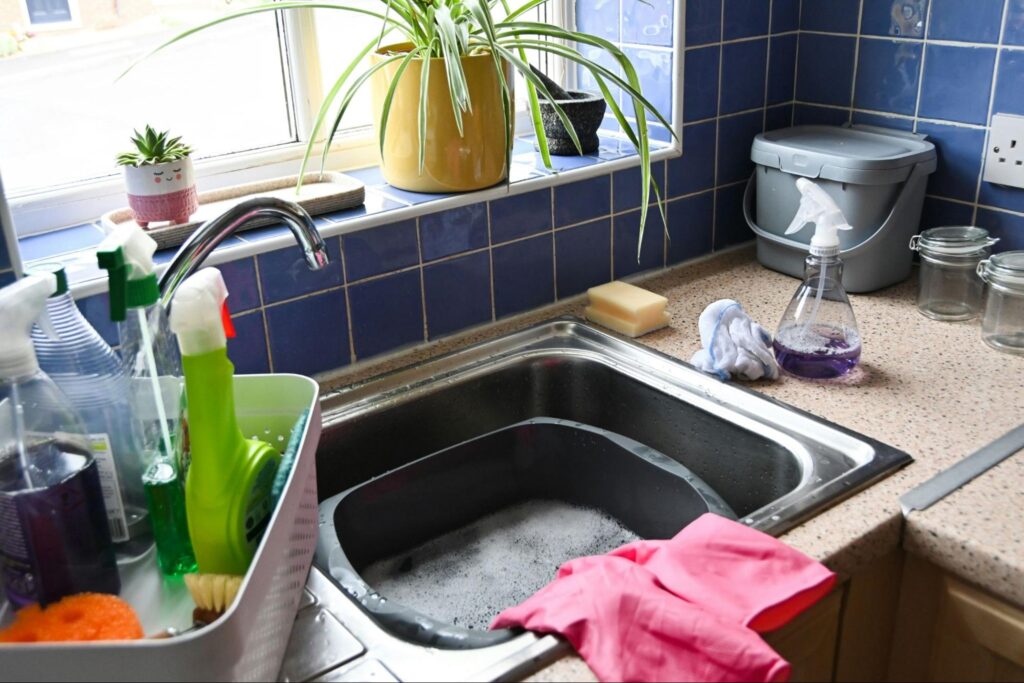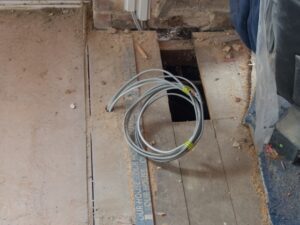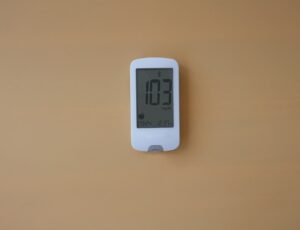Clogged drains are a common household nuisance that can disrupt your daily routine, but the good news is that you don’t always need to call a plumber right away. Sometimes, a simple home remedy is all it takes to get things flowing again.
One popular and effective solution is using a mixture of baking soda and vinegar. This simple combo creates a bubbling reaction that can break down blockages and leave your drains running smoothly.
But why rely on expensive plumbing services when you can handle minor clogs yourself?
Not only does using household items save you time, but it also cuts down on costs and uses environmentally friendly solutions. However, if these DIY fixes don’t work, or if you’d rather leave it to the experts, don’t hesitate to call in the pros.
At Excel Mechanical, we specialize in efficient, cost-effective solutions, whether you’re tackling a small clog or dealing with more complex plumbing issues. We’re committed to ensuring everything in your home or business runs smoothly – offering exceptional quality and great value with every job.
In this blog, we will cover:
- Simple and effective home remedies for unclogging drains
- Safety tips for using DIY solutions
- When to call a professional plumber for persistent clogs
Let’s get started!
Understanding Drain Clogs
Drain clogs can be a hassle in daily life. To deal with them effectively, it’s essential to know the types of clogs and what causes them. This knowledge can help you maintain your plumbing and prevent future issues.
Types of Drain Clogs
Different types of drain clogs can occur in your home.
- Hair and soap residue are common in bathroom sinks and tubs, forming sticky messes that slow water drainage.
- Kitchen sinks often suffer from food and grease buildup, creating thick blockages.
- Toilets can become clogged by excessive toilet paper or non-flushable items like wipes.
- Outdoor drains might face leaves, dirt, or other debris accumulating over time.
Understanding these types makes it easier to choose the correct solution. If you’re tackling a significant clog, professional help from a service ensures the problem is resolved efficiently.
They provide specialized tools and expertise to address any issue, whether you’re dealing with a kitchen sink or an outdoor drain problem.
Common Causes of Clogged Drains
Knowing what causes clogs helps prevent them.
- In bathrooms, hair, and soap scum are frequent culprits.
- In kitchens, food scraps and grease are often responsible. These items accumulate, creating layers that block water flow.
- Toilets face problems when items that should not be flushed are introduced, like wipes, cotton balls, or sanitary products.
Leaves and storm debris can obstruct drains outside, especially after heavy rain. Prevention involves regular cleaning and mindful disposal practices.
Safety Considerations for Home Remedies
When using home remedies to unclog a drain, it’s important to prioritize safety and know when it’s best to seek professional help. Simple precautions can protect you and your plumbing system.
Protecting Yourself and Your Plumbing
When using household ingredients, avoid harsh chemicals that can damage pipes. Wear gloves to protect your skin and goggles to shield your eyes from splashes. If using hot water, pour slowly to avoid burns.
Consider the material of your pipes. Baking soda and vinegar are generally safe, but not all metals or plastics react well. Overuse of these mixtures can erode certain materials.
Test any new solution on a small section of your drain first. This way, you can make sure it won’t cause damage. Avoid combining chemicals, like bleach and ammonia, as they can produce toxic fumes.
When to Call a Professional
If the clog persists after trying a home remedy, it may be time to call a professional.
Stubborn clogs can indicate a deeper plumbing issue. Instead of risking damage to pipes or drainage, rely on experts.
Excel Mechanical provides exceptional HVAC and plumbing services. We offer the best solutions tailored to your needs and budgets, whether for residential or commercial properties. We aim for quality and value in every service.
Seeking professional help can prevent costly repairs and ensure a lasting solution.
Baking Soda and Vinegar Method
Baking soda and vinegar are effective and natural solutions for unclogging drains. They combine common household items to create a bubbling reaction that can break down clogs without harsh chemicals.
Step-by-Step Instructions
- Clear the Area: Before you begin, remove any standing water to expose the drain. This ensures the mixture can effectively reach the clog.
- Add Baking Soda: Pour one cup of baking soda directly into the drain. Make sure it gets into the opening rather than in the surrounding area.
- Pour Vinegar: Add one cup of vinegar slowly. The mixture will start to fizz and bubble. Cover the drain with a plug or cloth to contain the reaction within the pipes.
- Wait and Flush: Allow the combination to work for about 30 minutes. After this time, flush the drain with hot water to remove any remaining debris.
Why This Method Works?
The baking soda and vinegar method leverages a basic chemical reaction to clear clogs.
Baking soda is a base, and vinegar is an acid.
When combined, they produce carbon dioxide gas. This bubbling action can help lift and break down build-up like grease or soap scum. This method is gentle on pipes, avoiding the damage that harsh commercial chemicals can cause. It’s also environmentally friendly, using simple ingredients found in most homes.
If this method doesn’t resolve the issue completely, consider contacting Excel Mechanical.
Boiling Water Technique
Using boiling water to unclog your drain is an easy and effective method. It helps to break up and flush away minor blockages caused by grease or soap buildup.
Learn how to use this technique safely and effectively to maintain clear drains and avoid potential issues.
How to Safely Use Boiling Water
Start by heating water in a kettle or pot until it reaches a rolling boil.
Carefully pour the hot water directly into the drain. This step helps dissolve and wash away any minor clogs, such as soap or grease. Repeat this process two to three times if necessary.
It’s important to ensure that your plumbing can handle very hot temperatures. This method works best with metal pipes, as extreme heat may damage plastic pipes over time. If unsure about your plumbing materials, consider contacting a professional for advice.
Remember to exercise caution when handling boiling water to avoid burns.
Manual Removal Tactics
Clogged drains can often be tackled with manual tools and techniques. Here are some effective methods you can use at home to handle stubborn clogs before calling a professional.
Using Plungers Effectively
Plungers are a versatile tool for many types of clogs.
- First, ensure a tight seal over the drain for maximum suction.
- If there are any overflow openings, block them with a wet rag. This improves suction and helps the plunger work more effectively.
- Fill the sink or tub with enough water to cover the plunger’s cup. The water acts as a medium to transfer the force.
- Push the plunger up and down rapidly a few times to build pressure. After a few attempts, remove the plunger to see if the water drains.
- Suppose it doesn’t repeat the process until the blockage is cleared.
A flange plunger is especially useful for toilets because its extended rubber flap fits snugly into the drain for better pressure.
How to Clean P-Traps
P-traps often collect debris, leading to clogs.
- Start by placing a bucket under the trap to catch water and debris.
- Unscrew the slip nuts connecting the trap, using pliers if necessary.
- Once removed, clean the trap thoroughly using a wire brush or an old toothbrush to remove buildup.
- Check for any debris lodged further in the pipes. After cleaning, reassemble the P-trap, ensuring the slip nuts are tight to prevent leaks.
- Run water to check if the clog is cleared. If done correctly, cleaning the P-trap is an effective way to clear many common clogs.
Employing Drain Snakes
Drain snakes are great for reaching deeper clogs.
- Start by inserting the snake into the drain slowly.
- Turn the handle clockwise to push the snake through the pipe. When you feel resistance, it means you’ve reached the clog.
- Continue rotating and pushing the snake to break up the clog or hook debris.
- Once you feel the blockage loosen, carefully retract the snake to avoid damaging the pipes. Clean off any debris from the snake before storing it.
A motorized auger will help tackle more severe clogs as these devices can extend further into the plumbing system, offering a more thorough solution.
Excel Mechanical Repairs
Consider calling a professional for more persistent issues where DIY solutions fall short.
Excel Mechanical offers top-notch HVAC and plumbing services, ensuring optimal system performance tailored to your needs and budget. Our skilled team provides tailored residential and commercial property solutions, ensuring reliable and efficient service.
Enzymatic Cleaners
Enzymatic cleaners are powerful solutions for unclogging drains. They use natural enzymes to break down organic matter, offering an eco-friendly and chemical-free alternative to traditional drain cleaners.
Selecting the Right Enzymatic Cleaner
When choosing an enzymatic cleaner, several factors must be considered to ensure effectiveness.
Look for products specifically designed for the type of clog you’re dealing with. Many enzymatic cleaners work well on buildups like grease, hair, or food particles.
Check the label for specific uses, such as kitchen or bathroom drains. Opt for products that are labeled as non-toxic and biodegradable. This ensures safety for both your family and the environment.
Before starting, read the instructions carefully. Some cleaners require an application time where the enzymes work best if left overnight. Regular maintenance with enzymatic cleaners can also prevent future clogs, reducing the need for harsh chemicals.
Maintenance and Prevention
Maintaining your drains and using preventive measures can help you avoid future clogs. Implementing regular cleaning routines and natural maintenance tips can be effective in keeping your drains trouble-free.
Regular Cleaning Routines
Cleaning your drains regularly is crucial to keeping them in top condition. Begin by running hot water through them weekly. This helps to clear out any minor build-up.
Another effective method is using a mixture of baking soda and vinegar. Pour 1/2 cup of baking soda and 1/2 cup of vinegar down the drain, then cover it. After about 15 minutes, flush with hot water.
It is also important to keep your drains free of debris. Use a drain cover to catch hair and other particles. Make it a habit to check and clean these covers frequently.
Natural Drain Maintenance Tips
Using natural ingredients can help maintain your drains without harsh chemicals.
- Lemon juice is a great option. Its acidity can break down greases and oils. Mix lemon juice with hot water and pour it down the drain every month. This not only cleans but also leaves a fresh scent.
- Another tip is to use salt and hot water. Pouring a mixture of salt and boiling water can help break down and move clogs starting to form. This is an especially good method for bathroom drains that tend to build up soap residue.
Conclusion
Unclogging a drain can often be managed with simple solutions. Using everyday items like baking soda, vinegar, or a plunger can effectively tackle many clogs. Start by pouring hot water down the drain, which can help break up minor blockages.
Safety Tips:
- Wear gloves to protect your hands.
- Avoid harsh chemicals that can damage pipes.
You might need to explore other options if these methods don’t work. A drain snake is a useful tool for reaching deeper into the pipes. When using it, twist it in a circular motion to catch and remove the obstruction.
Common Tools:
- Plunger: Creates suction to dislodge blockages.
- Drain Snake: Flexible and can navigate pipes easily.
Professional assistance may be necessary for more stubborn clogs. At Excel Mechanical, we specialize in residential and commercial plumbing services and provide tailored solutions to fit your needs and budget.
Frequently Asked Questions
Clogged drains are one of those annoying problems every homeowner faces at some point, and knowing how to effectively tackle them with home remedies can save time, money, and frustration. But what happens when the DIY fixes aren’t cutting it? Below, we’ll answer some of the most common questions people have when dealing with drain clogs and offer simple solutions that might just do the trick!
What is the best homemade drain cleaner?
A mix of baking soda and vinegar is popular for unclogging drains. Pour half a cup of baking soda and half a cup of vinegar. Cover and let it fizz for 15 minutes, then flush with hot water.
How can I unclog a drain using vinegar?
Combine equal parts vinegar and baking soda. Pour the mixture down the drain and let it bubble for a while to break down blockages. Rinse thoroughly with hot water to remove any residue.
How do you unblock a drain quickly and effectively?
For a quick fix, try plunging the drain first. If that doesn’t work, mix baking soda with vinegar. After it fizzes, flush with boiling water. This method is both simple and effective.
Can baking soda and vinegar damage drains?
Baking soda and vinegar are generally safe for most drains. They clean naturally and don’t cause harm when used occasionally. However, consider professional help like our services at Excel Mechanical for frequent clogs.
How can I unclog a bathtub drain naturally?
Remove the drain stopper and use a straightened wire hanger to remove hair and debris. Then, pour a combination of baking soda and vinegar, followed by hot water, to clear the remaining build-up.
Is it safe to use hydrogen peroxide to unclog drains?
Hydrogen peroxide can be a useful alternative. Mix it with baking soda and pour the solution down the drain. It dissolves organic materials, clearing the blockage without harsh chemicals.




